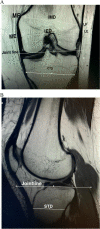Lateral epicondyle to the joint line distance is a precise landmark for determination of an accurate knee joint line: an observational retrospective study
- PMID: 37289300
- PMCID: PMC10250280
- DOI: 10.1186/s40634-023-00621-z
Lateral epicondyle to the joint line distance is a precise landmark for determination of an accurate knee joint line: an observational retrospective study
Abstract
Purpose: To assess a quantitative and reproducible association between the position of the knee joint line and recognizable anatomical landmarks around it in order to help in restoring joint line in arthroplasty cases.
Methods: Magnetic resonance imaging (MRI) of 130 normal knees were investigated. Anatomical measurements of the knee joint distances on the obtained planes were performed manually by distance measurements using a ruler tool, followed by 6 anatomical bony landmarks determination about the knee to identify the joint line which included the joint line, medial epicondyle, lateral epicondyle, medial flare, lateral flare, and proximal tibiofibular joint. The entire process was examined twice by two independent fellowship trained musculoskeletal radiologists, with a 2-week interval between the first and second sets of readings.
Results: The lateral epicondyle to the joint line of the knee (LEJL) could be a reliable landmark for accurate distance measurements for the knee joint line level, with an absolute distance of 24.4 ± 2.8 mm. The analysis showed that the femorotibial ratio between the LEJL and proximal tibiofibular joint (PTFJ) was 1.0 (LEJL/PTFJJL = 1.0 ± 0.1), confirming the location of the knee joint at the midpoint between the lateral epicondyle and PTFJ, revealing two identifiable landmarks.
Conclusions: LEJL is the most precise landmark for determination of an accurate knee joint line because the knee is located at the midline between the lateral epicondyle and PTFJ. These reproducible quantitative relationships can be widely employed in various imaging modalities to help restore the knee JL in arthroplasty surgeries.
Keywords: Accurate knee joint line estimation; Knee replacement surgery; Persistent pain; Recognizable anatomical landmarks; Varus malalignment.
© 2023. The Author(s).
Conflict of interest statement
The authors declare that they have no competing interests.
Figures
Similar articles
-
Identification of the joint line in revision total knee arthroplasty using a multiple linear regression model: a cadaveric study.Arch Orthop Trauma Surg. 2023 Aug;143(8):5239-5248. doi: 10.1007/s00402-023-04792-3. Epub 2023 Mar 27. Arch Orthop Trauma Surg. 2023. PMID: 36971801
-
Does robotic technology successfully restore the joint line after total knee arthroplasty? A retrospective analysis.Arthroplasty. 2022 Jan 5;4(1):6. doi: 10.1186/s42836-021-00103-6. Arthroplasty. 2022. PMID: 35236508 Free PMC article.
-
Calculating the Position of the Joint Line of the Knee Using Anatomical Landmarks.Orthopedics. 2016 Nov 1;39(6):381-386. doi: 10.3928/01477447-20160729-01. Epub 2016 Aug 3. Orthopedics. 2016. PMID: 27482732
-
Radiographical definition of the proximal tibiofibular joint - A cross-sectional study of 2984 knees and literature review.Injury. 2016 Jun;47(6):1276-81. doi: 10.1016/j.injury.2016.01.035. Epub 2016 Mar 3. Injury. 2016. PMID: 26975794 Review.
-
The reliability of adductor tubercle as an anatomical landmark for joint line restoration in revision knee arthroplasty: a systematic review.Ann Transl Med. 2021 Jan;9(1):71. doi: 10.21037/atm-20-3681. Ann Transl Med. 2021. PMID: 33553364 Free PMC article. Review.
References
LinkOut - more resources
Full Text Sources


